Simple and terrible weapon
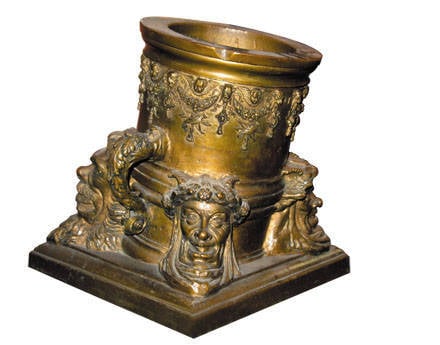
Who and when invented the first mortar? Alas, no one knows. The mortar ancestor was mortar. In any case, the first guns, dropping projectiles along steep trajectories (60 ° —80 °), appeared no later than the 15th century. These implements of mounted fire were very short (1,5 – 3 caliber in length), since it is difficult to put a projectile and charge into a long canal at a high muzzle position. Such a tool in its appearance resembled a mortar, and therefore received the name mortar (müser in German and mortiere in French means "mortar").
Mortars were shot from the cores, canister, small stones, placed in wicker baskets, various types of incendiary projectiles, etc. It is curious that in the 16th – 17th centuries, mortars were used as a means of delivering poisonous substances and bacteriological weapons. So, among the munitions that were in Kiev in the 1674 year, there are mentioned “fragrant fire cores”, and among these substances there is ammonia, arsenic and Assa fatuda. Mortar shells could be braided with the remains of animals or people infected with infectious diseases that were thrown through the wall into an enemy fortress. The main ammunition mortars were bombs - spherical shells, inside which were placed the explosive - black powder.
Mortar turned out to be a very conservative tool, and over the years 500 its design has not changed. At the same time, mortars with trunnions were manufactured, requiring a primitive lifting mechanism (usually a wooden wedge), and cast together with a pallet. In the latter, the firing range was changed only by changing the weight of the charge. All smooth mortars of the 15th – 19th centuries according to the modern mortar classification were arranged according to the “deaf scheme”, that is, the whole system was placed on one massive plate.
In mortars, scientists and designers experimented mainly on the chamber in order to improve ballistic qualities. Either it was made cylindrical, then conic. And in 1730, the French engineer de Vallier creates an 12-inch mortar with a chamber tapering towards the canal, that is, a semblance of a nozzle is obtained.
In 1751, a German engineer in the Russian service, a certain Venus drilled an 5-pud (13,5-inch) mortar from the breech and inserted an iron pin through which the fuse went through. At the end of the pin was an iron truncated cone, with which it was possible to change the volume of the chamber and thus change the firing range and provide the desired accuracy.
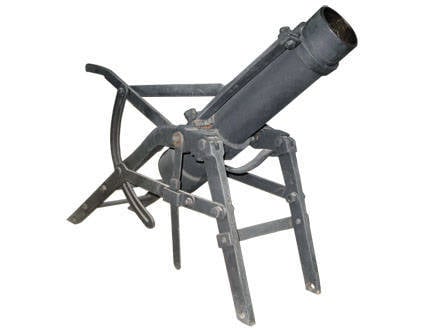
Created by General M.F. Rosenberg modeled on the captured German mortar.
Front view
With the advent of rifled guns in Russia, an entire system of rifled mortars of 1867 inches (1884 mm), 6 inches (152 mm), 8 inches (203 mm) and 9 inches (229 mm) was created in 11 – 280. All of them were very complex structurally: with recoil devices, guidance mechanisms, etc. The lightest of them, 6-dm fortress mortar arr. 1867 d. Weighed in a combat position 3120 kg without a wooden platform.
As for the light melee weapons, they were simply forgotten. By the 1914, their functions were performed by smooth-bore 5-, 2- and semi-pod mortars arr. 1838, as well as 6- and 8-pound Kegorne mortars. It's funny that, in the absence of a better War Department, in April 1915 of the year ordered fifty 6-pound Kegorna copper mortars on wooden machines and on 500 pieces of cast-iron spherical grenades to them. The order was executed by the Shkilin Petrograd Plant.
Mortar mortars made the invention of pyroxylin, and then other explosives, the high-explosive action of which was several times more powerful than gunpowder. The explosion of a projectile filled with a large amount of pyroxylin was, in visual effect and high explosive, similar to an explosion of a land mine. Naturally, the weapon that threw mines was called mortar.
In 1882, the captain of the fortress artillery Romanov projected a mine, which could shoot from conventional 2-pood smooth-bore mortars.
Mina was a thin-walled steel cylindrical shell caliber 243,8 mm, length 731 mm, weighing about 82 kg (including 24,6 kg of pyroxylin). An armored 533-meter wire that fits into a wooden box was attached to the head section. Mina was shot from the usual smooth-bore 2-pood mortar arr. 1838, in flight, pulled the wire behind itself, the blasting was carried out by applying an electric pulse, and the fuse and the wire were insulated from moisture.
In 1884 – 1888, in the Ust-Izhora sapper camp, Romanov mines were tested. Accuracy when firing on fortifications at a distance of 426 m was quite satisfactory. In the summer and autumn of 1890, experiments continued in Kronstadt. 5 October in the presence of the Minister of War fired 4 mines, one in a ditch filled with water, and simultaneously blew up. No failures were observed. On December 11, the Fortress Arms Commission ordered 400 mines, and in the summer of the following year they were used in exercises near the Novogeorgievsk fortress. By the way, then for the first time, for the correction of artillery fire, observers placed on balloons were used.
In mid-September, 1904, Major General R.I. Kondratenko, approved a proposal to use Hotchkiss 47-mm single-barreled cannon for firing over-caliber six mines equipped with pyroxylin. The technical implementation of the idea of creating such an improvised mortar was entrusted to Captain L.N. Gobyato.
Mina had the appearance of a truncated cone and was made of sheet iron. A wooden pole was attached to its wide base. At the free end of the pole were thickenings for jamming the guide wings. Before the shot, these wings could move freely along the pole. The mines were equipped with 6 – 7 kg of pyroxylin and had a percussion fuse.
At the first shooting pole often broke. Therefore, to mitigate the shock was made wad, which served as a buffer.
The wad consisted of a lead cone, a copper tube with a wooden liner and a lead cylinder that served as the lead girdle and did not allow the breakthrough of powder gases. All parts are connected by a copper tube. In this form, the wad was placed in the sleeve as a 47-mm projectile. The mortar had a firing range from 50 to 400 m at elevation angles from 45 to 65 °.
In addition, shooting mines on Japanese fortifications gave good results. In the “Artillery Magazine” No. 8 for 1906 a year in the article “Artillery shooting in a fortress at a distance closer than 1000 steps (from the siege of Port Arthur)” captain L.N. Gobyato wrote: “10 November on the left flank of High Mountain was delivered to 47- mm gun, and began regular shooting mines day and night. Shot on the left Japanese Sapa; the shooting results were such that 4 fired 3 mines fell into the trench. As soon as the Japanese began to work the sap, several mines were allowed in there, and after the first mine broke, the Japanese escaped; in this way they were forced to completely stop working. ”
In addition to the pole mines during the defense of Port Arthur, Russian sailors adapted mine gunpowder vehicles that were in service with boats for ground firing. 254 mm missile throwing sea mines and 74 kg weight were fired at a distance of up to 200 m. Throwing mine apparatus was a smooth-walled metal pipe that was closing from the breech and was intended for firing at short distances with caliber mines that had a spindle-shaped body about 2,25 m long and stabilized tail section. They were powerful melee weapons. Suffice it to say that the weight of the explosive charge of a mine was about 31 kg. Mortars firing caliber mines were installed in the field of the expected attack of the enemy. The firing of mines was conducted on assault columns or on the enemy entrenched in shelter. The use of new weapons was unexpected for the enemy, caused panic and caused great damage.
Between the wars, in 1906 – 1913, Russian engineers developed several mortar designs, and the Putilov factory produced two prototypes using the 43 caliber lines (122 mm) and 6 inches (152 mm).
Alas, the War Ministry, headed by cavalry general V. A. Sukhomlinov, was set up exclusively for a maneuverable lightning war. And there was an indication: "Order mortars should not be." It was about the mortars of the Putilov factory, then called trench mortars.
The situation is quite different in Germany.
By the beginning of World War I, the German army had 64 heavy 24-cm mortars and 120 medium-sized mortars 17 cm. In addition, several experienced light mortars were created. All German mortars had a deaf scheme, that is, the mortar itself and all the mechanisms were located on a massive base plate lying on the ground. Moreover, 24-cm and 17-cm mortars were supplied with normal anti-recoil devices, like field guns. Light mortars had a rigid (recoilless) scheme.
Fundamentally important was not the number of mortars from the Germans before the war, but the availability of waste systems that were already mass-produced during the war.
The First World War, only a few weeks after the start, acquired a positional character, and the troops urgently needed mortars. And only then did we begin to create various types of mortars, from artisanal homemade homemade products to copying foreign designs at large artillery mills.
Mortars, the bodies of which were made of their cannon shells, became widespread among homemade products. The scheme, of course, was deaf, the base plate was wooden, and the loading was done from the barrel.
3-dm (76-mm) mortar had as a body a brass sleeve from the 76-mm gun mod. 1902 g. For strength, the barrel was sealed with iron rings. The breech of the trunk was connected to the base plate with a hinge. By rearranging the front mortar support on the toothed rack on the base plate, it was possible to obtain elevation angles from 30 to 60 °. Firing range near 100 m.
The 107-mm mortar had the same design, the body of which was made of an 107-mm brass sleeve of the 42-linear gun mod. 1910 g. Both mortars were transferred by hand.
At the beginning of 1915, Russian Colonel Stender designed a mortar, the body of which was the body of an 152-mm projectile. Fault 152-mm marine armor-piercing shells were reamed from the inside to the diameter 127 mm. Shooting was conducted 127-mm cylindrical mines made of sheet iron. Mina was filled with 6,1 kg of trotyl or poisonous substance. With a propellant charge 102 grams of black powder, the firing range was about 360 m. Charging was done from the barrel. At first bags with a charge, then - a mine fell. In 1915, the Polyakovo factory ordered 330 Stender mortars.
Sometimes in parts they created “homemade products on the knee”, rigidly fixing the iron pipe on a wooden deck. As the deputy head of the State Agrarian University, E. Z. Barsukov, wrote, “the range of such bomb bombs did not exceed a hundred steps, they fired a“ canister ”from the material at hand, and shooting was not safe for the shooters themselves and demanded caution.
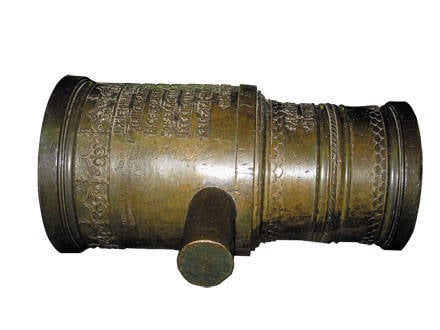
I note that in the 1914 – 1917 years, the same system was called a bomber and a mortar. A number of generals believed that a bomb bomb was a weapon firing a fragmentation projectile, and a mortar was a high-explosive. At the beginning of 1920's, the term "bomb" was obsolete.
5 November 1914 of the III Siberian Corps troops between the Bulepo and Tirkalo lakes from the Germans seized the 170-mm mortar of the Erhardt plant mod. 1912 g. And one shell to her.
170-mm mortar was delivered to the main artillery ground (GAP). 7 February 1915 was ordered to deliver this mortar to the Putilov factory.
The plant asked to reduce the caliber from 170 mm to 152 mm and introduce a pivoting mechanism on the model of an experienced mortar designed by the plant, as well as to simplify the platform.
The prototype 6-inch mortar was completed by the Putilov plant in mid-September 1915. During the tests revealed the fragility of the cradle, which, deformed, wedged the barrel of the mortar. The mirror periscope for the sight turned out to be inconvenient, and the plant suggested replacing it with a simple sight tube. It was finally decided to stop at three grooves with a steepness of 5 °, as on the 6-inch mortar of the Metal Works. GAP tests were renewed 22 October 1915 of the year.
The barrel of the 6-inch mortar of the Putilov factory is a monoblock pipe, closed from the breech. At the bottom of the channel ends with the chamber to place the charge. The channel had three rifling depths of 3,05 mm for shells with ready protrusions. Charging was done from the barrel.
The hydraulic compressor consisted of two cylinders located above and below the barrel. The thumb cage consisted of two columns of coil springs embedded in compressor cylinders. The recoil length is normal - 200 mm, maximum - 220 mm.
The lifting mechanism is a sector attached to the left axle of the cradle. The elevation angle was possible to + 75 °.
The machine rotated around the pin on the platform. The sector type rotary mechanism allowed for horizontal pointing angle 20 °. The machine was a box-like structure riveted from two steel forged beds interconnected by cross links.
The machine was installed on a wooden platform. When shooting platform was installed on the ground. For carriages, wooden wheels were worn on the platform pins.
Mortar could move manually like a car, muzzle forward. One number of the calculation held on to the drawbar, and two or three numbers in front were harnessed to the straps, thrown over the shoulder.
For movement in narrow places, the mortar was easily disassembled into parts: a) a trunk with a gun carriage; b) platform; c) wheels, drawbar, rule, etc.
The weight of the system in the combat position was 372,6 kg, and in the march - 441,4 kg.
6-inch mortars of the Putilov factory were fired with a high-explosive cast-iron bomb with a weight of 20,7 kg and a length of 2,3 klb. Explosive - 3,9 kg of ammonium.
On the side of the bomb near the bottom three leading projections made of bronze, copper or brass were screwed.
The same shells also fired 6-inch mortars of the Petrograd Metal Plant. With an initial speed of 99 m / s, the firing range was about 853 m.
The Mortar of Metal Plant was significantly more technological and cheaper due to the elimination of recoil devices and the mechanism of horizontal guidance. Its weight in the combat position was only 210 kg.
Mortars that fired above-caliber mines are much more widespread. As an example, consider the 47-mm mortar of the Lichonin system.
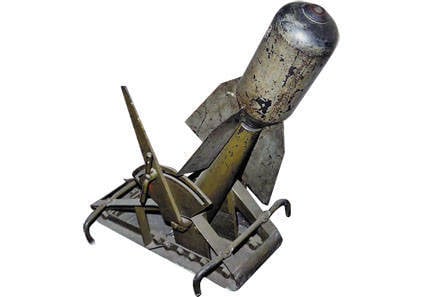
47-mm Likhonin mortar
The mortar was designed by captain E. A. Likhonin with the assistance of the engineers of the Izhora Steel Plant. The first Lichonin 47-mm mortar was tested on 22 May 1915 of the year. A total of 767 47-mm Lichonin mortars were manufactured at the plant.
The mortar consisted of a mortar body, a lock, a mast with a sector, a plumb and a protractor.
The barrel had a smooth channel for placing the tail of the projectile, a chamber for placing the sleeve with a charge and a rifled part for placing the lock. Steel barrel. At the same time with the trunk forged axle.
The mortar was loaded in the following way: the loader opened the lock, put the cartridge case with the charge into the chamber, lowered the lock by the handle into the rifled part of the gun barrel and turned it clockwise to the full. Next, the tail (ramrod) mines were lowered into the muzzle of the barrel. Before the shot, the loader pulled down the trigger, then threw back the fuse and pulled the cord attached to the tail of the trigger.
The carriage with the sector consisted of two iron frames connected by brackets for carrying the mortar and a sheet forming the base. Attached to this sheet is a bracket for driving an iron stake into the ground and a square for fastening the rule.
The mechanism of vertical guidance constructively provided an elevation angle from 0 ° to 70 °, but at angles smaller than 35 °, it was not recommended to shoot, since it was possible that the carriage could overturn.
For firing from a mortar, three calculation numbers are needed, and for a land mine, three more.
On the battlefield, the mortar was transported by one or two payload numbers. For transportation served wheel course, consisting of two wheels, worn on a steel axle. For convenience, the carriage of a mortar into the carriage was inserted iron rule with a handle. The mortar can be transferred manually by four numbers, for which sticks were inserted into the brackets. Mortar weight in the combat position 90,1 – 99 kg.
The mortar on the ground was fastened with an iron stake, driven through a hole in the base of the gun carriage.
Mortar rate of fire - up to 4 shots per minute.
The mortar ammunition consisted of three types of above-caliber mines. The most commonly used 180-mm high-explosive mines with an iron welded hull. At the bottom there was a hole for screwing in the tail, to which four iron wings of the stabilizer were riveted. Weight of a mine 21 – 23 kg (with ramrod), length 914 mm. Mina equipped with 9,4 kg of ammonium. Fuse - shock tube arr. 1884 of the year or 13 GT. With an initial speed of 60 m / s, the maximum firing range of an 180-mm welded mine was 320 m.
In the 1916 – 1917 years, Russia received fifty 9,45-inch heavy British mortars and one hundred and ten - 58-mm French mortars.
The 9,45-inch (240-mm) short-barreled English mortar of the Batignolles system was created according to a deaf pattern. Recoil devices were absent. Mortar barrel smooth. On the trunk was screwed to the breech with trunnions, which were invested in sub-guns of the machine. The lifting mechanism had two sectors.
Rectangular metal base. The platform is wooden. To install the mortar, it was necessary to dig a hole with a length of 1,41 m, a width of 1,6 m and a depth of 0,28 m.
The weight of the system in the combat position 1147 kg.
Charging was done from the barrel. Mina caliber steel weighing kg 68,4 (with stabilizer). The length of the mines without fuse 1049 mm. Weight of explosive in a mine 23 kg of ammonal or ammatol. With an initial speed of 116 m / s, the firing range was 1044 m. The rate of fire is one shot per 6 minutes.
English 9,45-inch mortars proved to be very dangerous for the calculations, as they often gave premature mine breaks, so after the 1917 of the year they were not used.
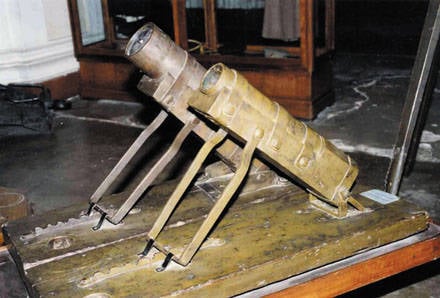
76-mm and 42-lin. (107-mm) Artisanal mortars 1914 – 1915
October 3 The 1932 of the year at the NIAP tested the 240-mm Batignol mortar converted to a gas-dynamic charge ignition scheme. For this, the mortar was equipped with a special chamber connected by a 40-mm nozzle with a barrel bore. The shooting was carried out with a 10 / 1 brand charge weighing 900 g and an 45 igniter g black powder. The initial velocity of the projectile in the first three shots was 120 – 140 m / s. On the fourth shot, the chamber was torn apart, and the tests were stopped.
For all its shortcomings, mortars were a very effective instrument of the First World War. Placed in advanced trenches, mortars hit the enemy defenses - dugouts, trenches, wire and other barriers. One of the important tasks of mortars was the destruction of machine guns and trench artillery - 37 – 47-mm guns and mortars. In the Russian “Manual for the Struggle for Fortified Bands”, published in 1917, it was required that the mortar groups should work under the cover of artillery. Under this condition, the impression was that only heavy batteries were fired, and the operating mortars did not attract the attention of the enemy.
Mortars have proven to be a very effective means of delivering chemical munitions. So, in July 1918, when the Germans attacked the city of Dorman on the Marne River, they opened storm mines with thousands of medium and heavy mortars with chemical mines.
The role of mortars in the Civil War was far less than in the 1914 – 1917 war. This was due to the transience of hostilities and the lack of mobile mortars.
In the first 10 years of Soviet rule, most of the mortars in the Red Army were pre-revolutionary systems, both domestic and foreign. The longest remained in service with 58-mm mortars FR and "Dumesil". By November 1 1936 of the Red Army, there were 340 pieces of them, of which 66 required major repairs.
From the middle of the 1920s, the design of new types of mortars began. Several dozens of heavy and medium mortar projects made according to a blind scheme were developed, and several hundreds of such mortars were manufactured.
Documentation on Soviet mortars created in 1925 – 1930 is still kept in secret archives. The fact is that they were created both for high-explosive and chemical projectiles. The mortar was immediately tested by firing chemical munitions, and there it was ... let's say, a lot of exotic things, such as experimental animals, but they say that it is not only animals.
During the conflict with China on the Chinese Eastern Railway in 1929, parts of the Special Far Eastern Army captured among other trophies several Chinese 81-mm mortars made according to the imaginary triangle with a rectangular base plate and which had a Stokes-Brandt ignition system.
With these mortars began a new story domestic mortars.
Information